 |
 |
 |
 |
 |
 |
2006 US Women's Open:
Battle By the Sea
Gallery 2 , Results
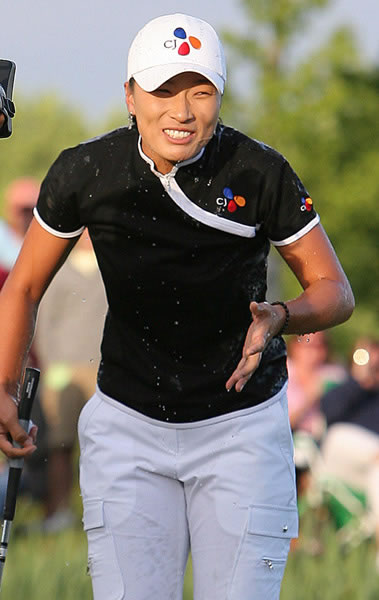 In
2006, the first two Majors of the year had both ended in spectacular fashion,
with an amazing shot by Karrie Webb getting her into a playoff at the
Nabisco (which she eventually won), and an equally amazing shot by Se
Ri Pak clinching the LPGA Championship for her. Also amazing were the
winners of these events: both were Hall of Famers who had dominated golf
much of the past decade, but who had fallen on tough times in the past
two years. With all the hype about the young golfers that were supposedly
challenging Annika Sorenstam for the top spot in women's golf, it was
very interesting that two proven superstars were the ones who claimed
these Majors.
In
2006, the first two Majors of the year had both ended in spectacular fashion,
with an amazing shot by Karrie Webb getting her into a playoff at the
Nabisco (which she eventually won), and an equally amazing shot by Se
Ri Pak clinching the LPGA Championship for her. Also amazing were the
winners of these events: both were Hall of Famers who had dominated golf
much of the past decade, but who had fallen on tough times in the past
two years. With all the hype about the young golfers that were supposedly
challenging Annika Sorenstam for the top spot in women's golf, it was
very interesting that two proven superstars were the ones who claimed
these Majors.
Combine the success of these two stars with the relatively weak play of Annika in 2006, and the year's third Major, the US Women's Open, had all sorts of possible outcomes. Would one of those superstars get the job done? Would one of the young guns finally live up to her billing and get the title? Would Michelle Wie, who had been knocking on the door at the past few Majors, finally break through here? Would we see amateurs again play a part, like they did in 2005? Which of the Korean stars who had taken the LPGA by storm might contend?
As exciting as all these possibilities were, the 2006 US Women's Open would have to go a long way to live up to the 2005 edition. Last year, Sorenstam came into the event having won the first two Majors of the year, looking to set herself up for a possible sweep of the Grand Slams. But she did not play very well, and after a couple of days had fallen too far behind to be a factor. After that, the spotlight was taken over by the young guns. Morgan Pressel, Brittany Lang, Michelle Wie and Paula Creamer were all near the top of the leaderboard as the final round began. But also near the top of the leaderboard were several young Korean stars who had never won on tour. One of them, Young Kim, had done very well in Majors in the past, but she would be the one who had the worst round on Sunday, quickly slipping out of contention. The other two were far more obscure: Young Jo and Birdie Kim. Both of these ladies stayed near the top of the leaderboard as most of the more vaunted young guns, including Creamer and Wie, slipped away.
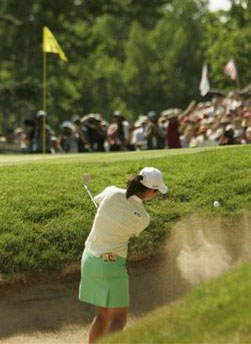 In
addition, Lorena Ochoa, the Mexican superstar, made a huge run at the
title on Sunday, but she blew it all with a quadruple bogey on the final
hole. Young Jo played well, but could not quite go low enough to have
a chance. Lang, an amateur who played for Duke University, made a bogey
on the final hole, but still finished with the low score at that point,
+5. This left only two players who could take her out: Pressel and Birdie
Kim. As every Seoul Sister fan doubtless knows, they reached the 18th
hole tied for the lead. Kim hit her approach into the bunker, then, with
Pressel watching from the fairway, hit her sand shot onto the green and
rolled it right into the cup for a birdie and the win. It was one of the
most sensational endings for a Major in history, and it turned perhaps
the most unlikely of the leaders into the champion of the biggest event
in her sport.
In
addition, Lorena Ochoa, the Mexican superstar, made a huge run at the
title on Sunday, but she blew it all with a quadruple bogey on the final
hole. Young Jo played well, but could not quite go low enough to have
a chance. Lang, an amateur who played for Duke University, made a bogey
on the final hole, but still finished with the low score at that point,
+5. This left only two players who could take her out: Pressel and Birdie
Kim. As every Seoul Sister fan doubtless knows, they reached the 18th
hole tied for the lead. Kim hit her approach into the bunker, then, with
Pressel watching from the fairway, hit her sand shot onto the green and
rolled it right into the cup for a birdie and the win. It was one of the
most sensational endings for a Major in history, and it turned perhaps
the most unlikely of the leaders into the champion of the biggest event
in her sport.
It was truly a Cinderella story for Ju Yun Kim, who had changed her English name to Birdie at the start of the year to help her stand out from the other Kims on tour. Nothing could be more ironic than having the newly christened Birdie make a birdie on the final hole to win the event. But the problem for Birdie came in following up her extraordinary victory. Ever since, she has struggled mightily, missing a bunch of cuts and not really contending in so much as a single event. Her start in 2006 has been, if anything, even worse than 2005. She has missed more cuts than she had made coming into the Open, with her best finish being a tie for 19th. She had only made one of her previous four cuts, and that finish, at the previous Major, the McDonald's LPGA Championship, only resulted in a tie for 65th. She certainly did not look primed for a repeat performance in 2006.
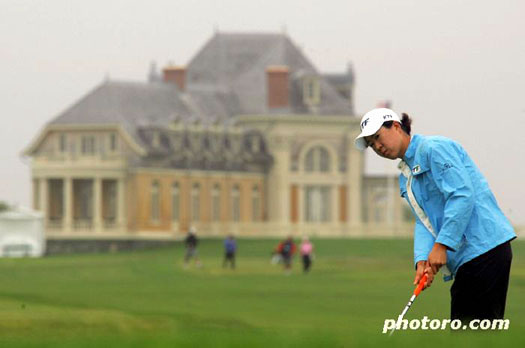 This
event moves to a different venue every year. This year it took place at
the Newport Country Club in Newport, Rhode Island. The course is a gorgeous
links style course situated right by the ocean. Like on British courses
of this type, there were few trees, devious bunkers, and plenty of long
grass if you ventured too far from the fairway. The course was dominated
by a giant clubhouse, which was visible from all parts of the layout.
It promised to be a wonderful test for the ladies.
This
event moves to a different venue every year. This year it took place at
the Newport Country Club in Newport, Rhode Island. The course is a gorgeous
links style course situated right by the ocean. Like on British courses
of this type, there were few trees, devious bunkers, and plenty of long
grass if you ventured too far from the fairway. The course was dominated
by a giant clubhouse, which was visible from all parts of the layout.
It promised to be a wonderful test for the ladies.
It also looked an awful lot like a British Open venue, which boded well for Jeong Jang, who tends to play very well on windswept courses. Not only was Jang coming off a victory at the previous event, the Wegman's LPGA, she was also the defending champion of the British Open. She looked like a strong candidate to win. Also coming in strong were Mi Hyun Kim, Hee-Won Han and Seon Hwa Lee, who had great short games and the necessary ability to keep the ball in the fairway. And although Se Ri Pak had not played well in Rochester, her great win at the LPGA Championship only three weeks before made her a player that couldn't be ignored.
The course was set up to be one of the longest in USGA history, but what really made it daunting was the weather leading up to the event. It had been remarkably rainy the previous few weeks, drenching the course and making it play far longer than it normally would. Standing water dotted the fairways and filled several bunkers; there would be many free drops taken to circumvent standing water during the tournament. But most significantly, if the course played longer, it would make things far tougher for the short hitters in the field. That might prove quite a problem for many of the top Koreans.
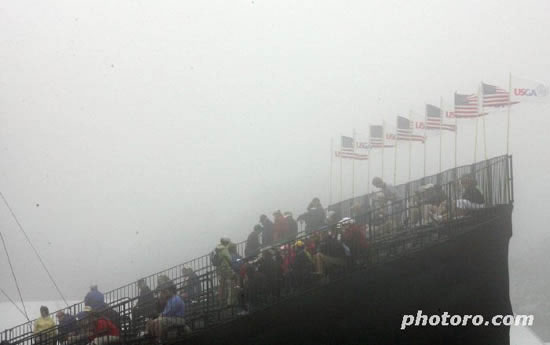 The
rain had been the story leading into the event, but it was a different
weather issue that caused problems on day one. Wednesday night the course
was blanketed in a thick fog, and as the day broke, the fog simply would
not go away. The USGA kept postponing the early golfers' start times,
and those golfers had to stay at the course all day, waiting for things
to get going. The afternoon golfers gained a huge advantage, because it
quickly became obvious that they would not be able to play on this day,
and so they were able to stay at their hotels and avoid the wait. Eventually,
the USGA scrapped all play on Thursday. They decided that they would play
the first day on Friday, the second on Saturday, make the cut, then play
the final 36 holes in one marathon session on Sunday. Because things would
be tight, there would be no repairing of golfers on Sunday, meaning you
might end up having golfers in contention paired with golfers who had
long since fallen well behind. But there was no way to avoid that; the
alternative was to wait until the third round was over before repairing,
and with time at a premium with so much golf to play, they couldn't do
that.
The
rain had been the story leading into the event, but it was a different
weather issue that caused problems on day one. Wednesday night the course
was blanketed in a thick fog, and as the day broke, the fog simply would
not go away. The USGA kept postponing the early golfers' start times,
and those golfers had to stay at the course all day, waiting for things
to get going. The afternoon golfers gained a huge advantage, because it
quickly became obvious that they would not be able to play on this day,
and so they were able to stay at their hotels and avoid the wait. Eventually,
the USGA scrapped all play on Thursday. They decided that they would play
the first day on Friday, the second on Saturday, make the cut, then play
the final 36 holes in one marathon session on Sunday. Because things would
be tight, there would be no repairing of golfers on Sunday, meaning you
might end up having golfers in contention paired with golfers who had
long since fallen well behind. But there was no way to avoid that; the
alternative was to wait until the third round was over before repairing,
and with time at a premium with so much golf to play, they couldn't do
that.
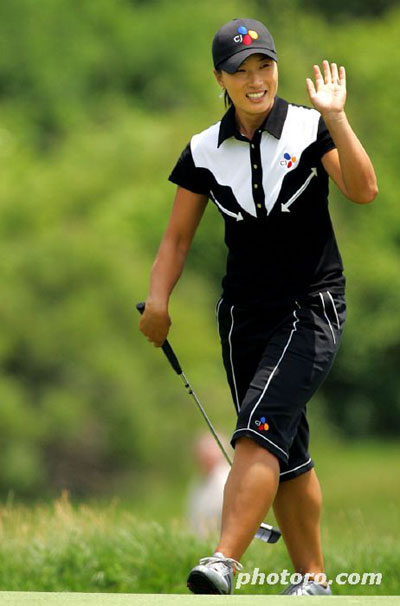 Action
finally got started on Friday. The conditions were still far from ideal.
For one, the wind was seriously nasty and hard to predict. And the wetness
of the course caused drives to stop dead with no roll, making things plenty
tough for the short hitters. The morning wave contended with these conditions,
and as one would expect, there were no outrageously low scores. But three
women finished at 2 under par 69 (this is a par 71 course), and two of
those women had Korean blood. The first one was none other than Se Ri
Pak, who got off to a wonderful start in her attempt to win back to back
Majors. Everything about her round was solid. She hit 12 of 14 fairways
and 13 of 18 greens in regulation. She had four birdies and only two bogies.
She even managed fewer than 30 putts in her round. If she could continue
this kind of play the rest of the week, she would have to be considered
a favorite to win it all. The other Korean blooded player to shoot 69
on this day was the Korean American amateur Jane Park. Park had established
herself as a great player when she won the 2004 US Women's Amateur after
finishing second at the 2003 edition. She had not played quite as well
since, but was still one of the top amateur golfers in the country. She
had just finished her Freshman year at UCLA, where she felt she had not
so far lived up to her golfing potential. For this event, she decided
to just go for it, without worrying too much about the consequences. It
remained to be seen whether her success in round one would affect the
way she played the rest of the week.
Action
finally got started on Friday. The conditions were still far from ideal.
For one, the wind was seriously nasty and hard to predict. And the wetness
of the course caused drives to stop dead with no roll, making things plenty
tough for the short hitters. The morning wave contended with these conditions,
and as one would expect, there were no outrageously low scores. But three
women finished at 2 under par 69 (this is a par 71 course), and two of
those women had Korean blood. The first one was none other than Se Ri
Pak, who got off to a wonderful start in her attempt to win back to back
Majors. Everything about her round was solid. She hit 12 of 14 fairways
and 13 of 18 greens in regulation. She had four birdies and only two bogies.
She even managed fewer than 30 putts in her round. If she could continue
this kind of play the rest of the week, she would have to be considered
a favorite to win it all. The other Korean blooded player to shoot 69
on this day was the Korean American amateur Jane Park. Park had established
herself as a great player when she won the 2004 US Women's Amateur after
finishing second at the 2003 edition. She had not played quite as well
since, but was still one of the top amateur golfers in the country. She
had just finished her Freshman year at UCLA, where she felt she had not
so far lived up to her golfing potential. For this event, she decided
to just go for it, without worrying too much about the consequences. It
remained to be seen whether her success in round one would affect the
way she played the rest of the week.
In the afternoon groups, Jeong Jang was paired with Morgan Pressel and Birdie Kim. This is the traditional pairing of the defending champion, the British Open champ and the US Amateur champ. But it also put into one group Morgan Pressel and the woman who had defeated her on the final hole in 2005, making for a potentially juicy combination. But Kim struggled right out of the gate and was never able to recover, shooting an 8 over par 79 on day one. She would go on to miss the cut by a wide margin. The other two women in that group, however, got out to a splendid start. Both JJ and Pressel made two quick birdies to move into a tie for the lead. After that, though, Pressel began to have a lot of trouble with her putter, and gave back many strokes as a result. She ended up shooting a 76, and though she would barely make the cut, would not be a factor again. Brittany Lang, too, struggled, so none of the top three finishers from 2005 would be important in the 2006 contest.
Jang, however, kept playing strong golf. She would end up shooting a 72, and found herself at one over par after one day. Only one player from the afternoon session joined the three leading players at the top. To no one's surprise, that player was Annika Sorenstam, who also shot a 69 on this day. With Se Ri and Annika tied at the top, the event promised to be a barnburner.